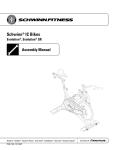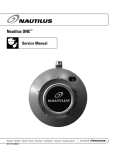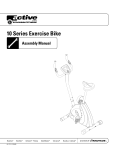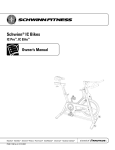Download Schwinn 418P Service manual
Transcript
Do not print this page ©2006. Nautilus, Inc. All Rights Reserved. Schwinn is a registered trademark. Nautilus, Inc., World Headquarters, 16400 SE Nautilus Dr., Vancouver, WA 98683 SCHWINN RETAIL ELLIPTICALS Service Manual This manual applies to the following models: 426 430 431 450 PN 001-6987 Rev B (03/07) SERVICE MANUAL CONTENTS Table of Contents Reading the Serial Number ................................................2 Troubleshooting ..................................................................3 Important Contact Numbers ..............................................16 reading the serial number Schwinn Elliptical Serial Numbers The serial number can be located on the underside of the machine base. The below instructions show how to decode the information contained in the serial number: Serial Number Scheme as Follows: AAAAAA: KIT NUMBER MODEL CC: COUNTRY CODE (ELECTRONIC REFERENCE DOES NOT APPLY TO STRENGTH PRODUCTS) 00-DOMESTIC, 110V, 60 HZ, US UNITS ENGLISH OVERLAYS 01-DOMESTIC, 220V, 60HZ, US UNITS ENGLISH OVERLAYS 02-INTERNATIONAL, 230V, 50HZ, METRIC UNITS ENGLISH OVERLAYS 03-INTERNATIONAL, 230V, 50HZ, METRIC UNITS GERMAN OVERLAYS H CONTACT HEART RATE 0-NO CONTACT HEART RATE 3-WITH CONTACT HEART RATE XXX MANUFACTURER/VENDOR (3 DIGIT CODE) SRS-SRS YY YEAR MM MONTH DD DAY ZZZ MACHINE NUMBER BUILT THAT PRODUCTION RUN Example serial number (Domestic 110V 430 Elliptical shown): 56 21 TROUBLESHOOTING BASIC Troubleshooting 1. Problem: No display/partial display/unit will not turn on Solution: A. Make sure the unit is plugged into a functioning wall outlet. B. Check the power connection at the front of the unit. Connection should be secure and undamaged. Replace the unit adapter or connection if either are damaged. C. Check data cable integrity. All cable wires should be intact. If any are visibly crimped or cut, replace the cable. D. Check data cable connections/orientation. Insure the cable is connected securely and oriented properly. The small latch on the connector should line up and snap into place. E. Check console display for damage. Check for any visual sign that the console display is cracked or otherwise damaged. Replace the console if damaged. F. Check console display. If the console only has a partial display and all connections are OK, replace the computer. Advanced Troubleshooting If any steps above do not resolve problems, proceed to ADVANCED TROUBLESHOOTING, problem A1. TROUBLESHOOTING BASIC Troubleshooting 2. Problem: Unit operates but Contact HR not displayed Solution: Note: Sensors may have difficulty with dried out or calloused hands. A conductive electrode cream such as “Signa Crème” or “Buh-Bump” can help make better conduct. These are available on the Web or at medical or some larger fitness stores. A. Insure hands are centered on the HR sensors. Hands must be kept still with relatively equal pressure applied to each side. B. Check the HR cable connection at the console. Insure the cable is connected securely to console. If the above tests reveal no problems, replace the console handle assembly. 3. Problem: Unit operates but Telemetric HR not displayed Solution: A. Check for interference. Try moving the unit away from sources of interference (TV, Microwave, etc.). If interference is eliminated and HR still does not function, replace the strap. If the problem persists, replace the console. 4. Problem: Console displays “E2” error code Solution: A. Check data cable integrity. All wires in the cable should be intact. If any are crimped or cut, replace the cable. B. Check data cable connections/orientation. Insure the cable is connected securely and oriented properly. The small latch on the connector should line up and snap into place. If the above tests reveal no problems, Motor, DC Servo should be replaced. TROUBLESHOOTING BASIC Troubleshooting TROUBLESHOOTING BASIC Troubleshooting 5. Problem: No speed/RPM reading Solution: A. Check data cable integrity. All wires in the cable should be intact. If any are crimped or cut, replace the cable. B. Check data cable connections/orientation. Insure the cable is connected securely and oriented properly. The small latch on connector should line up and snap into place. C. Check magnet position (requires shroud removal; see Advanced Troubleshooting, A6). The magnet should be in place on the flywheel. If no magnet is present, replace the flywheel magnet. D. Check RPM Sensor (requires shroud removal; see Advanced Troubleshooting, A6). The RPM sensor should be aligned with the magnet and connected to the data cable. Re-align the sensor if necessary; replace if there is any damage to the sensor or to the connecting wire. TROUBLESHOOTING BASIC Troubleshooting 6. Problem: Console shuts off (enters sleep mode) while in use Solution: A. Check data cable integrity. All cable wires should be intact. If any are crimped or cut, replace the cable. B. Check data cable connections/orientation. Insure the cable is connected securely and oriented properly. The small latch on the connector should line up and snap into place. C. Reset Machine (if equipped with reset button). Unplug the unit from the electrical outlet for three minutes. Reconnect to the outlet, and after the console powers up, press “reset”. D. Check magnet position (requires shroud removal; see Advanced Troubleshooting, A6). The magnet should be in place on the flywheel. If no magnet is present, replace the flywheel magnet. E. Check RPM Sensor (requires shroud removal; see Advanced Troubleshooting, A6). The RPM sensor should be aligned with the magnet and connected to the data cable. Re-align the sensor if necessary; replace if there is any damage to the sensor or to the connecting wire. TROUBLESHOOTING BASIC Troubleshooting 7. Problem: Fan (if equipped) will not turn on or will not turn off Solution: A. Check data cable integrity. All wires in the cable should be intact. If any are crimped or cut, replace the cable. B. Check data cable connections/orientation. Insure the cable is connected securely and oriented properly. The small latch on the connector should line up and snap into place. C. Reset Machine (if equipped with reset button). Unplug the unit from the electrical outlet for three minutes. Reconnect to the outlet, and after the console powers up, press “reset”. D. If the fan still does not function properly, replace the fan. If the problem persists, replace the console. TROUBLESHOOTING Basic Troubleshooting 8. Problem: Unit rocks/does not sit level Solution: A. Check leveler adjustment. Leveling feet may be turned in or out to level the elliptical. B. Check surface under unit. Adjustment may not be able to compensate for extremely uneven surfaces. Move the elliptical to a level area. C. If the problem is not resolved by performing tasks A. and B., re-assemble the machine per Step 2, Install Front Stabilizer and Extrusion Assembly, in the 430 Elliptical Assembly Guide. 9. Problem: Pedals loose/unit difficult to pedal Solution: A. Check pedal arm to crank connection. The pedal arm should be tightened securely to the crank. Insure the connection is not cross-threaded. B. Check crank to axle connection. The crank nut (found under the dust cap) should be tightened securely to the axle. Be sure the cranks are connected at 180 degrees from each other. TROUBLESHOOTING advanced Troubleshooting A1. Problem: No display/Unit will not turn on Solution: A. Check A/C adapter (assumes electrical outlet is OK). Use a volt meter to check the voltage output from the adapter. With the positive lead on the inside of the connector and negative lead on the outside, voltage should be within 9-14VDC. If the voltage is outside this range, replace the adapter. If the voltage is OK, check the computer. B. Check computer (assumes A/C adapter output is OK). Disconnect the upper wiring harness from the back of the computer. While power is supplied to the machine, use a volt meter to check that voltage is reaching the computer. Voltage between pins 1 (purple) and 3 (pink), (Figure A), should be within 9-14VDC. If the voltage is within range, replace the computer. If not, replace the upper wiring harness. Figure A 10 TROUBLESHOOTING advanced Troubleshooting C. Check upper wiring harness (assumes A/C adapter is OK, and no voltage is present at the end of the upper wiring harness). Remove the console mast and disconnect the upper wiring harness from the lower wiring harness. Test the output voltage at the lower harness using pins 1 and 3, as above. If the voltage is present is now between 9-14VDC, replace the upper wiring harness. If not, check the power plug wire. D. Check power plug wire (requires shroud removal; see Advanced Troubleshooting, A6). Note, this step assumes the AC Adapter is OK, and no voltage is present at the end of the lower wiring harness). Remove the shroud half that has the power plug mounted into it. Disconnect the power plug wire from the resistance motor wiring harness. Test the voltage output of the power plug wire. If no voltage is present, replace the power plug wire. If the voltage is within 9-14VDC, replace the Motor, DC Servo (includes lower wiring). 11 TROUBLESHOOTING advanced Troubleshooting A2. Problem: Resistance does not change (assumes unit powers up and otherwise functions normally) Solution: A. Check computer wire connections and continuity. Replace any damaged wires. If wire is OK, check servo motor. B. Check servo motor (requires shroud removal; see Advanced Troubleshooting, A6). Power up the unit and adjust the resistance level at the console, watching for movement at the servo motor. If the motor turns but the magnet arm assembly does not move, check and secure the mechanical components. Replace any damaged components. If the motor does not turn, check wire continuity and the integrity between the console and the DC motor. If all cables are good, replace the Motor, DC Servo. 12 A3. Problem: Drive train click/tick noise once per full crank revolution Solution: A. Check crank/pulley assembly. Disconnect left and right foot assemblies and rotate the crank. If sound persists, replace the crank/pulley assembly. If sound does not come from rotating crank, check the foot assemblies and the upper/lower handlebars. B. Check foot assemblies, leg assemblies, handlebar assemblies. Manually manipulate the foot, leg, and handlebar assemblies to isolate the sound. Tighten any loose joints that are making noise, or replace any noisy assemblies if the sound persists. 13 TROUBLESHOOTING advanced Troubleshooting TROUBLESHOOTING advanced Troubleshooting A4. Problem: Noise multiple times per revolution or once per 1.5 revolution. Solution: A. Check belt. Remove shrouds (see A6). Visually inspect the belt for irregularity while slowly rotating the pedals. Replace the belt if damaged. B. Check tensioner spring, pulley. Check that the belt tensioner spring is in place and functional. If the tensioner is in place but is not providing enough tension to prevent the belt from slipping, adjust or replace the tension spring. C. Check flywheel assembly. Slowly rotate the crank arms and listen closely for any sound from the flywheel hub. If sound is present, replace the flywheel bearings. 14 TROUBLESHOOTING advanced Troubleshooting A5. Problem: Certain pivots may make a squeaking noise while the machine is in use, and while addressing the problem, the user tightens the pivots too tight. Solution: Refer to Figures B and C to locate the four pivots (two on each side of the machine). Figure B Figure C A. Loosen hardware ¼ turn at a time until the unit no longer makes noise. The bolts all have a sufficient amount of loc-tite applied to them, so further loosening should not occur while the unit is in use. B. However, if three complete turn revolutions of the hardware are made, and there is still noise, the hardware should not be backed out any further, and other troubleshooting should be performed. Note: A petroleum-based lubricant may also need to be applied to the pivots shown above after prolonged use (suggested every three years). 15 TROUBLESHOOTING advanced Troubleshooting A6. Problem: Something wrong with the motor, flywheel, RPM sensor, or other internal components Solution: Access motor, flywheel, RPM sensor, or other internal components. - First, remove shrouds (Figure D): remove Phillips head screws securing right and left shrouds. - As needed, remove either right or left crank, or both, using a crank puller to remove covers for accessing internal components. - Disconnect left and right foot assemblies and all movement arms. - Detach power plug wire Figure D from front of shrouds and lift off shrouds. Internal components can now be inspected or replaced as needed (Figure E). Figure E Flywheel Magnet Pack Assy Motor, DC Servo Flywheel Magnet RPM Sensor Crank Bearings Crank Pulley 16 If you need assistance, please have both the serial number of your machine and the date of purchase available when you contact the appropriate Nautilus office listed below. OFFICES IN THE UNITED STATES: E-mail: [email protected] • NAUTILUS INNOVATION CENTER Nautilus, Inc. 1886 Prairie Way Louisville, Colorado, USA 80027 INTERNATIONAL OFFICES: For technical assistance and a list of distributors in your area, please call or fax one of the following numbers. • INTERNATIONAL CUSTOMER SERVICE: Nautilus International S.A. Rue Jean Prouvé 6 1762 Givisiez / Switzerland Tel: + 41-26-460-77-77 Fax: + 41-26-460-77-70 Email: [email protected] Phone: 800-NAUTILUS (800-6288458) Fax: 800-898-9410 • TECHNICAL/CUSTOMER SERVICE Nautilus, Inc. World Headquarters 16400 SE Nautilus Drive Vancouver, Washington, USA 98683 Phone: 800-NAUTILUS (800-6288458) Fax: 877-686-6466 • CORPORATE HEADQUARTERS Nautilus, Inc. World Headquarters 16400 SE Nautilus Drive Vancouver, Washington, USA 98683 Phone: 800-NAUTILUS (800-6288458) INTERNATIONAL OFFICES: • SWITZERLAND OFFICE Nautilus Switzerland S.A. Tel: + 41-26-460-77-66 Fax: + 41-26-460-77-60 • GERMANY and AUSTRIA OFFICE Nautilus GmbH Tel: +49 2203/20 20-0 Fax: +49 2203/20 20-45 45 • ITALY OFFICE Nautilus Italy s.r.l. Tel: +39-051-664-6201 Fax: +39-051-664-7461 • UNITED KINGDOM OFFICE Nautilus UK Ltd. Tel: +44-1908-267-345 Fax: +44-1908-267-346 • CHINA OFFICE Nautilus Representative Office Tel: +86-21-523-707-00 Fax: +86-21-523-707-09 17 IMPORTANT CONTACT NUMBERS IMPORTANT CONTACT NUMBERS






























